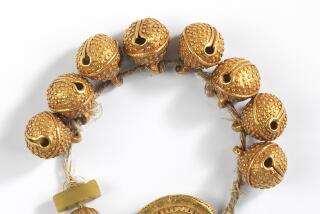King Tut’s Tomb Being Reborn in All Its Glitter : Egypt: Artisans are re-creating it on an island south of Cairo. It will reflect the sparkling world Englisman Howard Carter first glimpsed in 1922.
- Share via
CAIRO — Artisans are re-creating one of the great moments of archeology on an island south of Cairo.
On Nov. 26, 1922, English archeologist Howard Carter opened the tomb of the boy Pharaoh Tutankhamen and found a glittering world of delicate statues, inlaid chests, feather-light fans and decorated coffins of solid gold.
The riches he discovered amazed the world.
Now, 68 years after Carter peered into the small tomb in southern Egypt, the artisans are fashioning Tut’s nether world once again, working from photographs and other records. The replicas of Tut’s treasures are to be entombed as the archeologist saw them.
Twenty-two artists, sculptors, engineers and university students are rekindling craftsmanship unseen since the days of the Pharaohs.
They are halfway through their assignment: to duplicate his four-chambered tomb and 1,000 of the 1,703 Tut objects in the Egyptian Museum, as they were left by priests 3,313 years ago and the robbers who came later.
Ever-watchful jackals, goddesses in sleek gowns, open-mouthed lions and even the boy Pharaoh himself, out for a walk in thonged sandals, cram the bustling workshop on Jacob’s Island.
A year from now, every day on Jacob’s Island will be Nov. 26, 1922.
Until then, people wanting to marvel at King Tut’s storied world must travel to the two places they have visited for decades: the treasure hoard in Cairo’s Egyptian Museum and his tomb, with the mummy, 450 miles to the south, in the Valley of the Kings.
“It’s the wonder that we must produce in our tomb--the shock, which you don’t feel when you see the objects away from the tomb,” said Mahmoud Mabrouk, a sculptor and art professor who directs the Jacob’s Island project.
“We work as a team, just as the ancients did,” he said.
Novices think Tut’s treasures were all of solid gold. There was plenty of that, but there also were objects of wood, silver and other metals, alabaster, ivory, leopard skins, leather, pottery and gemstones.
Decisions on whether to replicate individual items, big or small, were based on whether they were important to history or to art knowledge.
The project is costing 1 million Egyptian pounds (almost $360,000) and is the brainchild of former diplomat Hassan Ragab, an entrepreneur who revived Egypt’s extinct papyrus industry.
In 1985, he opened his Pharaonic Village on Jacob’s Island, where tourists come to view life from the days of King Tut, but without the boy Pharaoh himself.
“Dr. Ragab asked me to create a full-scale tomb with exact copies of objects so that tourists would feel the wonder as Carter felt it,” Mabrouk said. “The tomb was no problem, but nobody knew how to make the objects. Everybody I talked with told me to refuse the offer.”
Mabrouk, who advises an international committee working to save the Sphinx, said he accepted the challenge for two reasons.
“First, I wanted to enter the mind of the ancient artist,” he said. “What kind of people were these, to create things so beautiful, but things that would never be seen by the living?
“Today, we artists have exhibitions and everybody congratulates us. Not these artists. Their creations were locked up with Tut.”
The second reason harks back to Mabrouk’s childhood.
“I was 12 when my brother and I saw the Tut collection in the museum,” he said. “We were so happy, but we were sad. The objects were beautiful, but nobody knew anything about them.
“I want Egyptian youth to look back on their history with a sense of pride, a sense of identity. It’s an Arab problem that Egyptians turn their backs on anything about the Pharaohs.”
Mabrouk said he is astounded by the quality of Tut relics. “We had to start with the simplest items,” he said. “Once we mastered the techniques, we could tackle the most difficult.”
Reproduction has been made more difficult because objects in the museum must be examined from behind glass and many Tut objects are locked in storerooms. Books contain conflicting information, and Mabrouk said many of Carter’s notes are inaccurate.
Even lowly artifacts proved tricky. A simple pair of sandals took three months to reproduce.
Many of the 50 alabaster items from the tomb were lovingly worked with exquisite designs. Alabaster posed one of the toughest challenges.
“We spent six months working in alabaster factories outside the Valley of the Kings, just to see how to use the stone,” Mabrouk said.
More to Read
Sign up for The Wild
We’ll help you find the best places to hike, bike and run, as well as the perfect silent spots for meditation and yoga.
You may occasionally receive promotional content from the Los Angeles Times.






